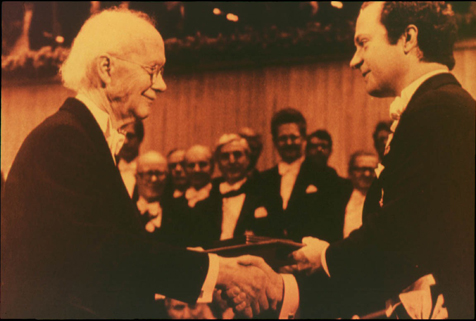
Faculty Research 1980 - 1989
Assay of oxysterol-binding protein in a mouse fibroblast, cell-free system. Dissociation constant and other properties of the system.
Document Type
Article
Publication Date
1981
Keywords
Carrier-Proteins: me, Cytosol: me, Hydroxycholesterols: me, Kinetics, L-Cells: me, Mice, Molecular-Weight, SUPPORT-U-S-GOVT-P-H-S
First Page
13068
Last Page
13073
JAX Source
J-Biol-Chem. 1981 Dec 25; 256(24):13068-73.
Grant
CA02758
Abstract
Procedures for determining a 7.5 S oxysterol-binding protein in the cytosol fraction of cultured mouse fibroblasts were developed. The methods involved precipitation of cytosolic proteins between 0.3 and 0.4 saturation with (NH4)2SO4, incubation of the proteins with 25-hydroxy[3H]cholesterol at 0 degrees C and analysis by velocity sedimentation of 7.5 S radioactivity or of specific binding using dextran-charcoal to adsorb free sterol. By these means it was shown that binding of the ligand to the protein in a citric acid-phosphate buffer was optimal at pH 5.5 and that the sedimentation rate of the complex was greater at pH 7.4 (7.5 S) than at pH 5.5 (6.9 S). The binding protein was essentially saturated at a diol concentration of about 20 X 10(-9) M. The apparent Kd of the sterol-protein complex was approximately 3.9 X 10(-9) M. Cholesterol did not bind to 25-hydroxycholesterol-binding sites on the 7.5 S protein, whereas several oxysterols that are potent suppressors of 3-hydroxy-3-methylglutaryl CoA reductase also inhibited the binding of 25-hydroxycholesterol. One of these sterols, 5 alpha-cholest-8(14)-en-3 beta-ol-15-one was shown to compete for sites occupied by 25-hydroxycholesterol.
Recommended Citation
Kandutsch AA,
Shown EP.
Assay of oxysterol-binding protein in a mouse fibroblast, cell-free system. Dissociation constant and other properties of the system. J-Biol-Chem. 1981 Dec 25; 256(24):13068-73.

